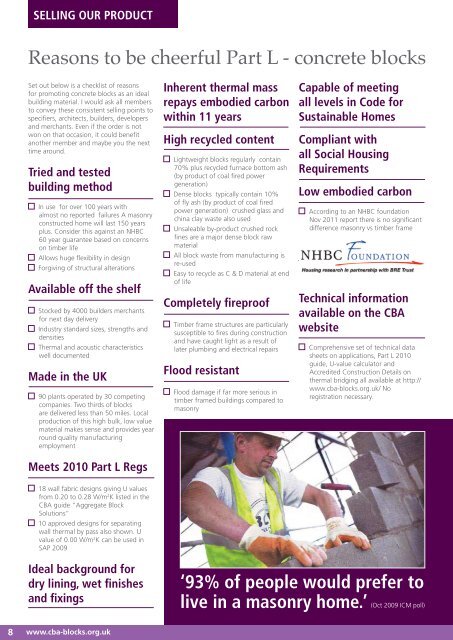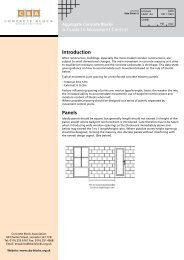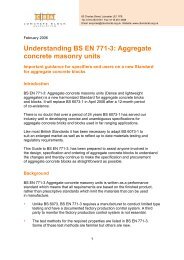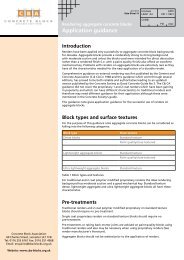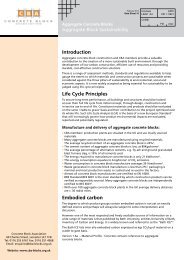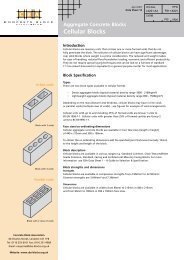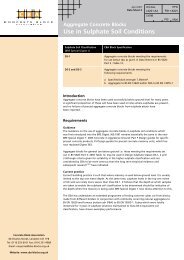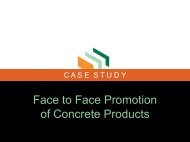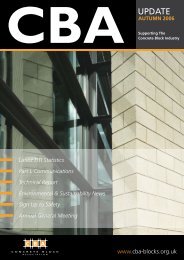Latest CBA Newsletter - Concrete Block Association
Latest CBA Newsletter - Concrete Block Association
Latest CBA Newsletter - Concrete Block Association
You also want an ePaper? Increase the reach of your titles
YUMPU automatically turns print PDFs into web optimized ePapers that Google loves.
selling our product<br />
Reasons to be cheerful Part L - concrete blocks<br />
Set out below is a checklist of reasons<br />
for promoting concrete blocks as an ideal<br />
building material. I would ask all members<br />
to convey these consistent selling points to<br />
specifiers, architects, builders, developers<br />
and merchants. Even if the order is not<br />
won on that occasion, it could benefit<br />
another member and maybe you the next<br />
time around.<br />
Tried and tested<br />
building method<br />
In use for over 100 years with<br />
almost no reported failures A masonry<br />
constructed home will last 150 years<br />
plus. Consider this against an NHBC<br />
60 year guarantee based on concerns<br />
on timber life<br />
Allows huge flexibility in design<br />
Forgiving of structural alterations<br />
Available off the shelf<br />
Stocked by 4000 builders merchants<br />
for next day delivery<br />
Industry standard sizes, strengths and<br />
densities<br />
Thermal and acoustic characteristics<br />
well documented<br />
Made in the UK<br />
90 plants operated by 30 competing<br />
companies. Two thirds of blocks<br />
are delivered less than 50 miles. Local<br />
production of this high bulk, low value<br />
material makes sense and provides year<br />
round quality manufacturing<br />
employment<br />
Meets 2010 Part L Regs<br />
Inherent thermal mass<br />
repays embodied carbon<br />
within 11 years<br />
High recycled content<br />
Lightweight blocks regularly contain<br />
70% plus recycled furnace bottom ash<br />
(by product of coal fired power<br />
generation)<br />
Dense blocks typically contain 10%<br />
of fly ash (by product of coal fired<br />
power generation) crushed glass and<br />
china clay waste also used<br />
Unsaleable by-product crushed rock<br />
fines are a major dense block raw<br />
material<br />
All block waste from manufacturing is<br />
re-used<br />
Easy to recycle as C & D material at end<br />
of life<br />
Completely fireproof<br />
Timber frame structures are particularly<br />
susceptible to fires during construction<br />
and have caught light as a result of<br />
later plumbing and electrical repairs<br />
Flood resistant<br />
Flood damage if far more serious in<br />
timber framed buildings compared to<br />
masonry<br />
Capable of meeting<br />
all levels in Code for<br />
Sustainable Homes<br />
Compliant with<br />
all Social Housing<br />
Requirements<br />
Low embodied carbon<br />
According to an NHBC foundation<br />
Nov 2011 report there is no significant<br />
difference masonry vs timber frame<br />
Technical information<br />
available on the <strong>CBA</strong><br />
website<br />
Comprehensive set of technical data<br />
sheets on applications, Part L 2010<br />
guide, U-value calculator and<br />
Accredited Construction Details on<br />
thermal bridging all available at http://<br />
www.cba-blocks.org.uk/ No<br />
registration necessary.<br />
18 wall fabric designs giving U values<br />
from 0.20 to 0.28 W/m 2 K listed in the<br />
<strong>CBA</strong> guide “Aggregate <strong>Block</strong><br />
Solutions”<br />
10 approved designs for separating<br />
wall thermal by pass also shown. U<br />
value of 0.00 W/m 2 K can be used in<br />
SAP 2009<br />
Ideal background for<br />
dry lining, wet finishes<br />
and fixings<br />
‘93% of people would prefer to<br />
live in a masonry home.’ (Oct 2009 ICM poll)<br />
8 www.cba-blocks.org.uk


